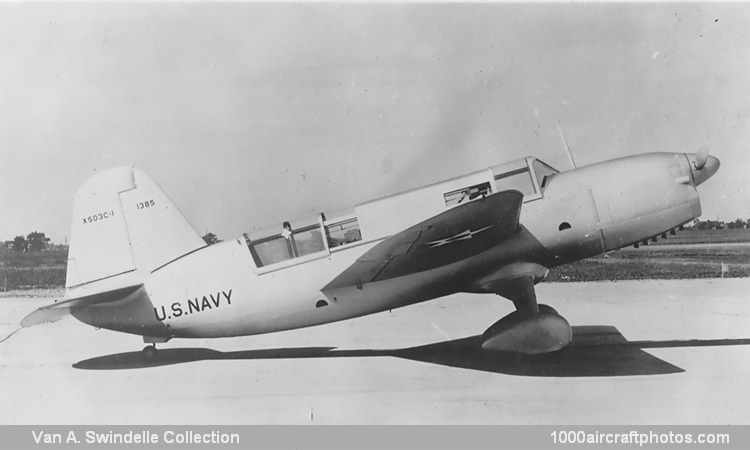07/31/2013. Remarks by Johan Visschedijk: "The third model to be called Seagull by Curtiss (the first two were a flying boat and a biplane), this two-seat Scout Observation monoplane was the first to use it as an official US Service name. The British named their version Seamew. Intended to replace the obsolescent SOC, the SO3C was an entirely new mid-wing monoplane design operable on wheels or floats. It was plagued with aerodynamic problems plus those of the troublesome Ranger V-770 engine and by excessive weight caused by additional USN equipment requirements.
There were 795 production aircraft but the type was retired by March 1944; some were actually replaced in the fleet by SOCs, the model the SO3C was designed to replace. Delivery of SO3Cs had only been completed in January 1944. A projected SOR-1, the SO3C-1 to be built by Ryan, and the SO3C-4, a deck-landing version, were not built.
XSO3C-1 Seagull (Model 82). The prototype XSO3C-1, BuNo. 1385 in the second series, was ordered on May 9, 1938. Built at Buffalo, it first flew on October 6, 1939. It was a conservative mid-wing two-seat monoplane designed to the same general specification as the competing Vought XOS2U-1 and XSO2U-1. Power plant was the 450 hp Ranger V-770-6, an inverted air-cooled V-12 that obtained high power from small displacement through greater crankshaft speed. Armament was a single fixed 0.30 in (7.62 mm) machine gun and a flexib1e 0.30 in (7.62 mm) in the rear cockpit. Wing racks could carry two 100 1b (45 kg) bombs or two 325 1b (147 kg) depth charges.
SO3C-1 Seagull (Model 82A). The production SO3Cs were built at Columbus, and 141 SO3C-1s were delivered under the initial contract for 300, BuNos. 4730 to 4783 and 4793 to 4879 in the second series. Deliveries began in July 1942. The aerodynamic problems of the prototype were somewhat alleviated in the production models by redesigned wing tips and tail surfaces. The early SO3C-l s were soon retired and some were converted to expendable radio-controlled aerial targets.
SO3C-1B Seamew (Model 82C). SO3C-1s were to be built for the Royal Navy as SO3C-1B, but these were delivered as SO3C-2C.
SO3C-2 Seagull (Model 82B). Fitted with 320 hp V-770-6 engines and 24-volt electrical systems, the last 150 aircraft of the initial SO3C order, plus 50 others, were completed as SO3C-2, BuNos. 4880 to 5029 in the second series and 04149 to 04198 in the third.
SO3C-2C Seamew. SO3C-2s fitted with arrester gear for deck landings and 250 (to have been SO3C-1Bs) were built under USN BuNos. 22007 to 22256 and and these also carried RN serials FN450 to FN649 and JW550 to JW599. Instead of two machine guns of the same caliber, this version was fitted with a single fixed 0.30 in (7.62 mm) machine gun and a flexib1e 0.50 in (12.7 mm) one. When operating on wheels, the Seamew could carry a 500 lb (227 kg) bomb under the fuselage. Seventy went to Canada and thirty additional Seamews ended up as radio-controlled targets called Queen Seamews, including RN serials JX663 to JX669 and JZ771 to 774.
SO3C-3 Seagull (Model 82C). The 150 SO3C-3s, BuNos. 04199 to 04348, were essentially SO3C-2s put through a weight-reduction program in an attempt to improve performance."
